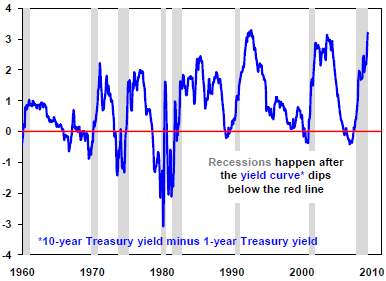

Friday, 26 February 2010
The Recession Is Most Certainly Over
By Dr. Steve Sjuggerud
"There are still no jobs here," my friend Lee tells me.
Lee used to work for a beachfront resort on Florida's east coast. Our town was built on tourism and real estate. Both are dead. The resort is on the brink of bankruptcy.
I told you Lee's story a few months ago in DailyWealth. The situation isn't any better today. I lent
him some money recently... which I know I might not see again.
Officially, Florida's unemployment rate is 12%. But unofficially, it has to be much worse... When
20% of Palm Beach County residents are 90 days or more behind on their mortgage (as I wrote
With all this terrible news in Florida, what I'm about to say might sound crazy to you. But I
believe it is true: The recession is most certainly over. In fact, the more likely scenario is a
boom.
Let me show you why with one simple indicator...
The indicator is the "yield curve." And it's saying there's definitely no risk of recession now.
The "yield curve" is a simple idea. A "normal" yield curve simply shows that if you want to borrow
money for a year, the interest rate is lower than if you want to borrow money for 10 years.
That's "normal" because it's riskier to lend someone money for 10 years than one year...
so you demand a higher rate of interest for a 10-year loan.
Normally, the difference between long-term interest rates and short-term interest rates is
about one percentage point. That's what it's averaged over the last 50 years. So when interest
rates on 10-year government bonds are at 4%, as they are now, then interest rates on
one-year bonds should be 3%.
So that's normal. But when the government – the Federal Reserve, actually – tries to steer the
economy, it makes a mess of "normal." And when it does, recessions ALWAYS follow.
For example, if the Fed wanted to slow the economy down today, it would raise short-term
interest rates over 4%. That would upset the natural order of things. It would make it
expensive and difficult for banks and businesses to make money. It would lead to recession.
The chart on this page shows it... when the blue line drops below zero, it means the Federal
Reserve raised short-term interest rates above long-term interest rates.
In every single instance in the last 50 years (except for one in 1966), a recession follows.
(Economic growth fell to zero in the second quarter of 1967, so a stealth recession happened in
that case as well.)
When you think about it, you could say the Federal Reserve actually causes recessions, by
forcing short-term interest rates to a painfully high level.
That's what it did in 2006/2007. The yield curve was "inverted." Short-term interest rates were
above long-term rates. And then the Great Recession hit.
Now the Federal Reserve is doing the opposite... It has cut short-term interest rates to artificially
low levels again. The "yield spread" is now as wide as it's been at any time in the last 50 years, as
the chart shows.
It is the recipe for another boom. The Fed is artificially creating a boom. That boom, of course,
will end when the Fed raises rates too high someday down the road, and the cycle begins again.
So the Fed artificially pushing interest rates too high is our signal a recession is coming. We're
definitely not there yet. According to this indicator, the bigger risk going forward is a great
boom, rather than a "double-dip" recession like many are calling for.
Times feel really tough out there. I know it. I live on the coast of Florida, Ground Zero of the
housing bust and the subsequent economic bust.
But I strongly believe the worst is over. One reason is the yield curve. This indicator has a
fantastic track record. It's saying we're not headed into another "dip." It's saying there's a boom
ahead.
Good investing,
Posted by
Britannia Radio
at
15:00
![]()





















